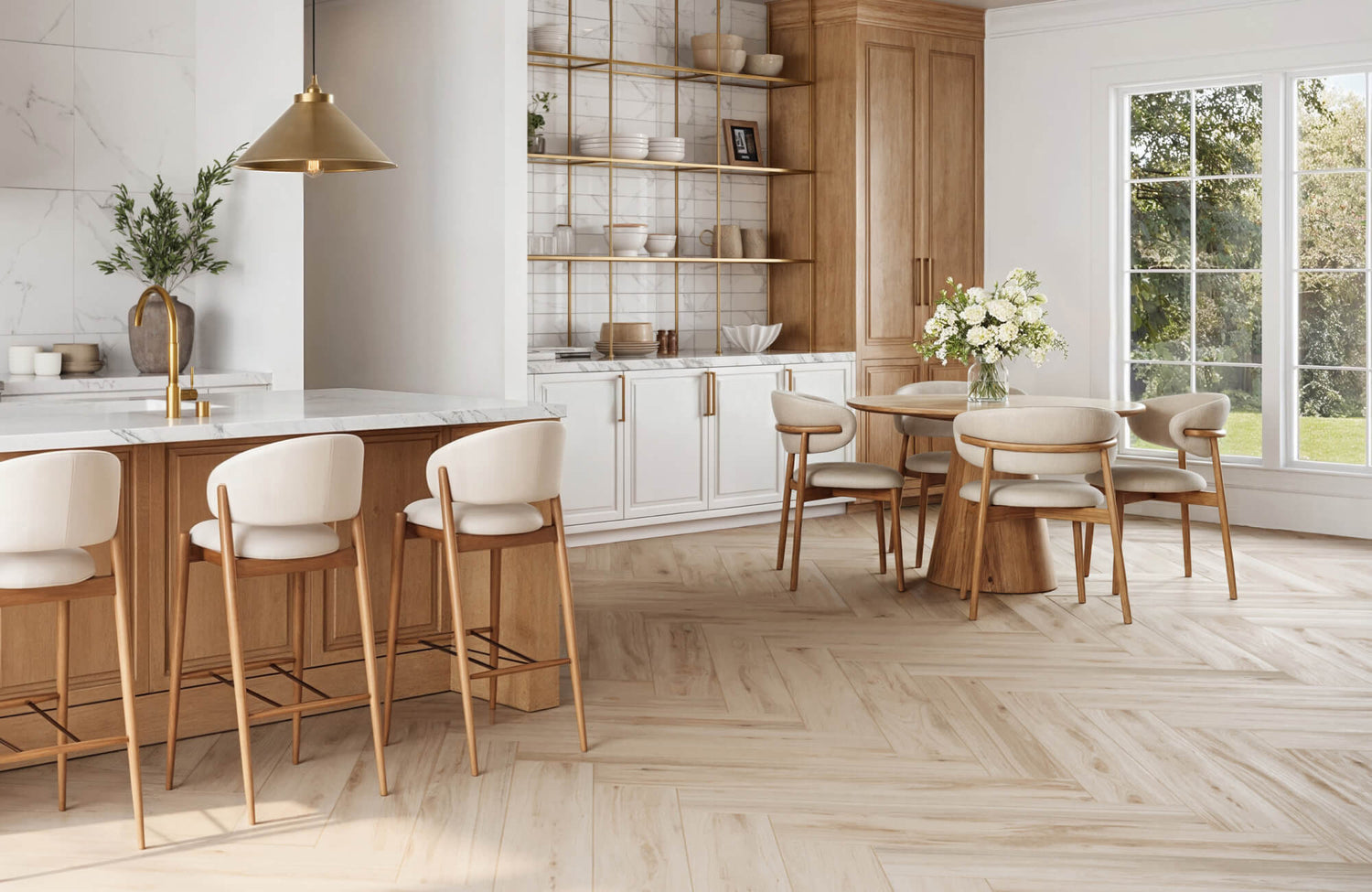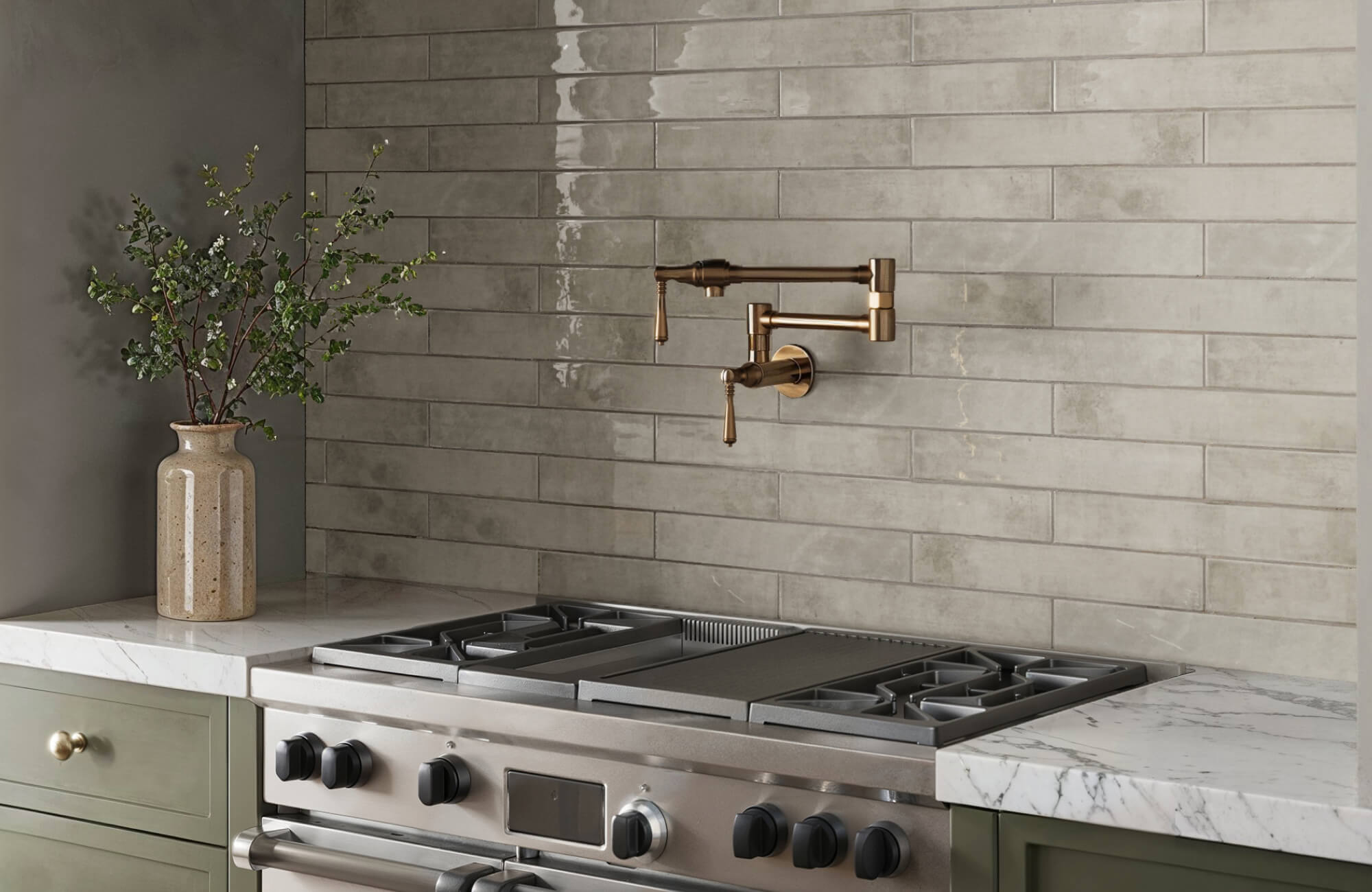Wood look tiles combine the visual appeal of hardwood with the durability and resilience of tile, making them a popular choice for homeowners who want a stylish yet practical flooring solution. While they require less upkeep than natural wood, questions about sealing often arise, as factors such as tile composition, placement, and daily use influence the need for added protection. This guide explores when sealing is necessary, the types of sealants available, and how to preserve the appearance and longevity of your wood look tiles.

Understanding the Composition of Wood Look Tiles
While wood look tiles capture the warmth and charm of natural wood, their unique composition affects how they should be maintained and whether sealing is necessary. Designed to resist moisture and wear, they offer a durable alternative to hardwood, but their porosity and surface finish influence their susceptibility to stains and water absorption.
Porcelain vs. Ceramic Tiles
Wood look tiles are typically made from porcelain or ceramic, with their primary differences rooted in density and durability. Porcelain wood look tiles, produced using finer clay and fired at higher temperatures, have a water absorption rate of less than 0.5%, making them denser and highly resistant to moisture. This eliminates the need for sealing, making options like the Jameson 8x48 Matte Porcelain Tile in Camel an excellent choice for bathrooms, kitchens, and other moisture-prone areas.
Ceramic wood look tiles, though non-porous due to their glazed surface, are slightly less dense than porcelain, making them better suited for walls rather than floors. Their tendency to chip under heavy impact makes them ideal for accent walls, backsplashes, and other decorative installations. Edward Martin's Zayne 12x36 Matte Ceramic Tile in Slat, as shown above, offers a stylish, textured look while remaining durable in low-impact areas. To ensure proper care, it’s important to identify your tile type by checking the packaging, consulting the manufacturer, or reviewing product specifications.
The Role of Glaze in Tile Protection
Most wood look tiles, especially those made of porcelain, feature a glazed finish that enhances their color while providing excellent resistance to stains and moisture. This protective layer makes the tiles easy to clean and helps maintain their appearance over time, even in busy areas. While the glaze is highly durable, sealing the grout in moisture-prone areas adds extra protection, helping maintain the tile’s longevity and appearance.

Deciding Whether to Seal or Not
Glazed porcelain and ceramic tiles do not require sealing, but unglazed versions are more porous and may benefit from a sealant to prevent staining and moisture absorption. Sealing is especially useful in high-moisture areas, helping to maintain the tile’s durability and appearance over time.
Assessing Your Lifestyle
Daily use and cleaning habits play a crucial role in determining whether sealing is necessary. In high-activity spaces like kitchens and entryways, frequent spills and abrasive cleaning methods can wear down the tile's protective glaze. Additionally, homes with pets or young children may also experience more staining risks, making sealing a practical choice. If your cleaning routine involves harsh chemicals, sealant can also help protect both the tiles and grout from long-term damage.
Considering the Tile's Location
The placement of your wood look tiles significantly impacts their exposure to moisture and potential wear. Bathrooms, kitchens, and laundry rooms face constant humidity and direct water contact, which can weaken grout and accelerate surface wear over time. Sealing provides an extra layer of defense in these environments, especially if the glaze begins to degrade or if grout becomes more porous with age. In contrast, areas like living rooms and bedrooms typically experience minimal moisture exposure, eliminating the need for sealing—though periodic resealing of grout may still be necessary over time.
Cost Breakdown
Sealing requires an upfront investment, but it can reduce long-term maintenance costs. Proper sealing helps prevent stains, water damage, and premature wear, minimizing the need for deep cleaning or repairs. Penetrating sealers help protect grout and porous tiles by absorbing into the surface to enhance water resistance without changing the tile’s appearance.
DIY sealing costs vary depending on the type of sealant, ranging from $20 to $50 per gallon, while professional services typically range from $1.50 to $3.00 per square foot. While optional for some tiles, sealing can extend the lifespan of your flooring, making it a worthwhile consideration in high-moisture or high-use areas.

Exploring the Types of Sealants
If sealing is needed, the right type protects against moisture and stains while preserving the tile’s appearance, with the choice depending on the required protection and installation conditions.
Penetrating Sealers
As mentioned, penetrating sealers absorb into grout lines and, when applied to porous tiles, can also provide internal protection. By creating a hydrophobic barrier, they help repel water and prevent stains from setting in. Since grout is typically more porous than wood look tiles, it benefits the most from this type of sealant. Silicone-based penetrating sealers, in particular, are commonly recommended for their strong water-resistant properties. To apply, the sealer is brushed onto the grout lines and left to absorb before any excess is wiped away from the tile surface.
Topical Sealers
Topical sealers create a protective film on the surface of the tile and grout, acting as a barrier against stains, moisture, and surface scratches. Common types of topical sealers include acrylic and urethane varieties. Acrylic sealers are easier to apply but generally offer less durability, while urethane sealers provide superior protection but may require more detailed surface preparation. The choice between them depends on the type of wood look tiles, the level of protection needed, and the ease of application.

The Sealing Process and Maintenance
Proper application and periodic reapplication help maintain a sealant’s effectiveness against moisture and wear. Regular cleaning with the right products extends its lifespan, while professional installation ensures optimal protection.
Preparing the Surface
Before applying any sealant, it’s important to clean the tile surface thoroughly to remove dirt, debris, and any residue from previous sealants. Using a neutral pH cleaner specifically designed for wood look tiles and grout helps protect the glaze while ensuring an optimal surface for sealing. Once cleaned, the wood look tiles should be rinsed with fresh water and left to dry completely, as applying sealant to a damp surface can prevent proper adhesion and reduce its effectiveness.
Applying the Sealant
The application method varies depending on the type of sealant being used. Penetrating sealers should be carefully applied to the grout lines with a brush or applicator, allowing the solution to fully absorb before wiping away any excess from the tiles. In contrast, topical sealers require a thin, even coat spread across the surface using a roller, sponge, or applicator to create a protective barrier. To achieve the best results, it is important to follow the manufacturer's guidelines for drying times and reapplication. Additionally, ensuring proper ventilation and wearing protective gear, such as gloves, will help maintain safety during the process.
Post-Sealing Care
After applying the sealant, it is important to allow it to cure completely according to the manufacturer’s instructions before using the tiled surface. Rushing this process can compromise the sealant’s ability to provide long-term protection. To preserve its effectiveness, regular cleaning with a neutral pH cleaner is also recommended, as harsh chemicals can gradually wear down the protective layer. If the sealant begins to show signs of wear, such as reduced water resistance or a dull appearance, reapplying it will help restore protection and keep the wood look tiles in optimal condition.
Tile Sealing Comparison Chart
| Tile Type | Water Absorption | Sealing Needed | Recommended Sealant |
| Porcelain | Very low | Grout only | Penetrating grout sealer |
| Ceramic | Low | Grout only | Penetrating grout sealer |
| Natural stone | High | Tiles and grout lines | Penetrating sealer and penetrating grout sealer |
Addressing Common Concerns and Misconceptions
Sealing wood look tiles is not always necessary and depends on the tile’s characteristics and location. Proper application, regular cleaning, and periodic reapplication help maintain its effectiveness and long-term protection.
Frequency of Resealing Wood Look Tiles
Another point of confusion is how often resealing is needed. The answer largely depends on the type of sealant used and how the space is utilized. Penetrating sealers generally last between one to three years before needing reapplication. White topical sealers, which form a protective layer on the surface, may require more frequent maintenance, especially in areas with constant use. Following the manufacturer's guidelines and observing signs of wear will help determine the appropriate resealing schedule.
Impact of Sealing on Tile Appearance
A common misconception is that sealing dramatically alters the look of tiles. In reality, penetrating sealers typically have little to no effect on the wood look tile’s appearance, as they work below the surface. Topical sealers, however, can enhance the sheen or deepen the color, giving the tiles a glossier finish. For those concerned about aesthetic changes, it’s always a good idea to test the sealant on a small, inconspicuous area before applying it to the entire surface.
Risks of Over Sealing Tiles
While sealing can protect wood look tiles, applying too much sealant or resealing too often can cause issues. Oversealing may result in a hazy film, sticky residue, or discoloration, particularly on the tile surface or grout lines. This buildup not only affects the appearance but can also trap dirt, making cleaning more difficult. If oversealing occurs, professional cleaning or a specialized sealant remover may be required to restore the tiles to their original condition.
Sealing Wood Look Tiles
The need for sealing wood look tiles depends on tile type, location, and maintenance requirements. Porcelain tiles, with their low water absorption and durable glaze, rarely need sealing, while ceramic tiles and grout may require extra protection in moisture-prone areas. Evaluating your space and choosing the right sealant, if needed, can enhance durability and simplify maintenance, ensuring your wood look tiles stay beautiful for years to come.
If you're unsure whether sealing is necessary or want to see how different tile options will look in your space, our AR tool allows you to preview your selections in real time before making a decision. This interactive experience helps you choose with confidence, ensuring the perfect fit for your needs. For personalized advice on sealing, tile selection, or maintenance, feel free to contact us! Our team is ready to guide you toward the best solutions, helping your wood look tiles stay beautiful and durable for years to come.








